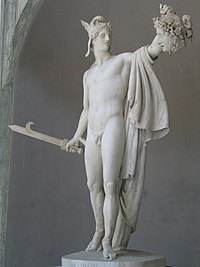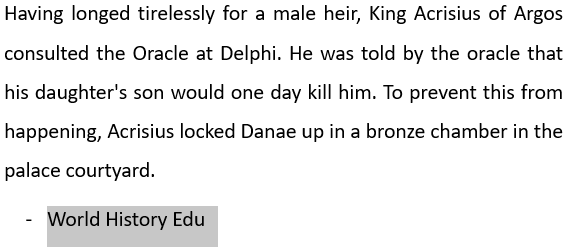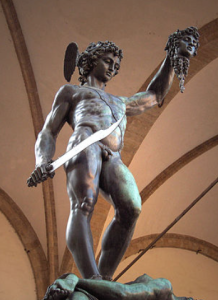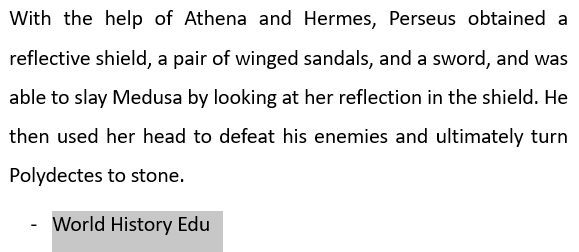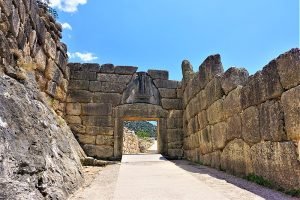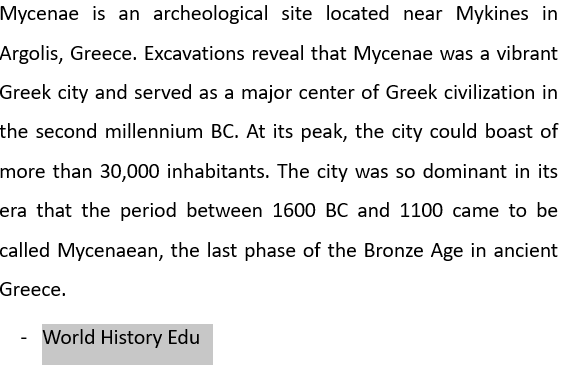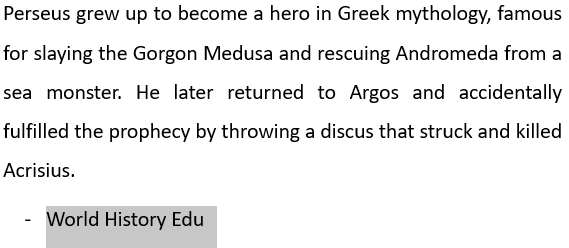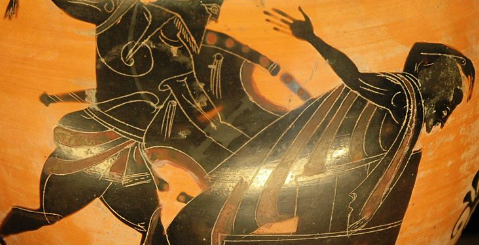Perseus in Greek Mythology: Origin Story, Family, & Adventures
Perseus is a figure from Greek mythology who is known for his heroic deeds and adventures. He was the son of Zeus and Danaë, and was famous for slaying the Gorgon Medusa and rescuing Andromeda from a sea monster. How did Perseus and Medusa’s paths get intertwined? And why did the Greek hero slay Medusa?
In the article below, World History Edu explores the life and adventures of this Greek hero, as well as other major things that he is best known for.
Perseus: Quick Facts
Father: Zeus
Mother: Danaë
Siblings: Apollo, Ares, Angelos, Athena, Dionysus, Helen of Troy, Hephaestus, Heracles, Hermes, Minos, the Horae, the Moirai, Persephone, Eris, Eileithyia, Aeacus
Consort: Andromeda
Sons: Perses, Alcaeus, Electryon, Cynurus, Mestor, Heleus, Sthenelus,
Daughters: Gorgophone, Autochthe
Best known for: slaying Medusa; founder of Mycenae; great-grandfather of Heracles
Meaning of Perseus
According to some scholars and mythologists, this Greek hero’s name has its roots in the Greek word pértheinm, which means “to waste” or “to destroy”. In some cases, Perseus’ name has been interpreted as “destroyer of cities”.
The birth of Perseus
According to the myth, Perseus was born when Zeus visited the mortal woman Danaë in the form of golden rain. The myth goes on to say that Danaë gave birth to him while imprisoned by her father, King Acrisius.
Perseus’ Father
Zeus is the king of the gods in Greek mythology. He was the son of Cronus and Rhea and was born on the island of Crete. Zeus was known for his power and his thunderbolt, which he used to control the weather and strike down his enemies.
Zeus was also associated with hospitality, oaths, and justice, and he was often depicted as a protector of guests and strangers. He was known for his numerous love affairs and marriages, and he fathered many children, including Athena, Apollo, and Artemis.
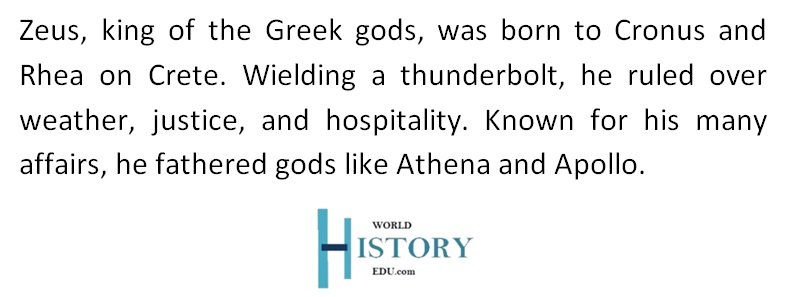
Read More: 9 Most Famous Sons of Zeus
Perseus’ Mother and the prophecy from the Oracle at Delphi
Danaë is a figure from Greek mythology who was the daughter of King Acrisius of Argos. According to legend, an oracle predicted that Acrisius would be killed by his grandson, so he locked Danaë in a tower to prevent her from having any children. However, Zeus, who had taken a fancy to Danaë, visited her in the form of a shower of gold and impregnated her.
To protect Danaë and her child, Acrisius had them cast out to sea in a chest, but they eventually landed on the island of Seriphos, where Perseus was raised by the fisherman Dictys, the brother of King Polydectes.
Perseus and King Polydectes
Having fallen deeply in love with Danaë, King Polydectes became envious of Perseus as the Greek demigod would not allow Polydectes anywhere near Danaë. Perseus saw Polydectes as a dishonorable man. As a result, an enmity developed between the two men. Therefore, the king came up with a plan to get rid of Perseus.
Polydectes demanded that Perseus bring him the head of Medusa as a gift. Medusa was terrifying gorgon whose gaze turned people to stone. The King assumed that Perseus would fail, and he would be free to pursue Danaë.
Perseus and Medusa
Perseus, however, was aided in his quest by the gods Hermes and Athena, who gave him a sword and a shield and helped him find the lair of the Gorgons. He was able to slay Medusa by using his shield to look at her reflection instead of directly at her, which turned her to stone.
Read More: The Three Gorgons in Greek Mythology
Perseus kills Polydectes
Upon his return to Seriphos with the head of Medusa, Perseus discovered that Polydectes had been abusive towards his mother, and he used the head of Medusa to turn him and his courtiers to stone. He then gave the kingdom to Dictys, the fisherman who had helped him and his mother during their exile on the island.
According to an alternate version of the story as told by Latin author Gaius Julius Hyginus, Polydectes married Danaë after Dictys brought her to him, and he raised Perseus in a temple of Athena. In this version, Polydectes did not mistreat Danaë and Perseus but instead protected them from Acrisius, who had discovered that they had survived and had come to Seriphos to kill them. Perseus made a pledge not to kill his grandfather, but at Polydectes’ funeral games, Perseus accidentally struck Acrisius with a discus, causing his death.
Perseus and the Graeae
In his quest to secure the weapons to defeat Medusa, the gorgon, Perseus was asked to find the Hesperides, the Nymphs of the West. But first, he had to seek the Graeae, sisters of the Gorgons who knew the whereabouts of the Hesperides.
The Graeae were three sisters who shared one eye and one tooth between them. Reluctant to give Perseus the information that he wanted, the Greek demigod had to find a way to get the information from them.
Perseus managed to steal the Graeae’s eye while they were passing it between them and refused to give it back until they revealed the location of the Nymphs. The Graeae eventually agreed, and Perseus set off to find the Nymphs and eventually slay the Gorgon.
In some versions of the myth, Perseus also tricked the Graeae into revealing how to defeat Medusa by threatening to keep their eye forever. In others, he used the eye to navigate his way through the realm of the Gorgons.
Items that aided Perseus in his fight against Medusa
Perseus was equipped with a range of powerful items to aid him on his quest to slay the Gorgon Medusa. The Hesperides provided him with a knapsack, known as a kibisis, to safely contain Medusa’s head.
Zeus gave him an adamantine sword, also known as a Harpe, and Hades’s helm of darkness to conceal his presence. Additionally, Hermes lent Perseus a pair of winged sandals to allow him to fly, while Athena presented him with a polished shield. With his arsenal at the ready, Perseus set off towards the Gorgons’ cave.
Exactly how did Perseus slay Medusa?
As Perseus entered the Gorgons’ cave, he found Medusa sleeping. Using his polished shield as a reflection, he was able to approach her safely and swiftly decapitate her. In a moment of wonder, Pegasus, the legendary winged horse, and Chrysaor, the golden-sworded giant, sprang forth from her severed neck. The two remaining Gorgons gave chase, but Perseus, protected by his helm of darkness, was able to escape.
Perseus and the Greek Titan Atlas
After this feat, Perseus continued on to King Atlas, seeking his hospitality, but was met with rejection. In response, Perseus revealed the head of Medusa, turning the king to stone as a punishment.
Read More:
- The Twelve Titans in Greek Mythology
- Everything you need to know about Atlas, the Greek Titan that carried the heavens on his shoulders
Perseus and Andromeda

Perseus also rescued Andromeda, a princess who had been chained to a rock as a sacrifice to a sea monster. He used the head of Medusa to turn the monster to stone and marry Andromeda.
During his journey back to Seriphos, i.e. from slaying Medusa, Perseus made a stop in the kingdom of Aethiopia (Ethiopia), a mythical land ruled by King Cepheus and Queen Cassiopeia. However, the queen’s pride led to disaster when she boasted that her daughter Andromeda was as beautiful as the Nereids. As punishment, Poseidon sent a sea serpent called Cetus to wreak havoc on the land, destroying both people and animals.
The oracle of Ammon revealed to the terrified people of Ethiopia that the only way to stop the devastation was to sacrifice Andromeda to the monster, and so the princess was bound and left naked on the shore. But Perseus arrived just in time, slaying the beast and freeing Andromeda. As a result, he won her hand in marriage.

Perseus Freeing Andromeda by Italian painter Piero di Cosimo (c. 1515) – the Uffizi Gallery in Florence, Italy.
During the marriage ceremony, a brawl broke out between Perseus and Phineus, son of Belus. Andromeda had earlier been promised to Phineus before the arrival of Perseus. Enraged by the actions of Perseus, Phineus plotted against the savior of Ethiopia. According to Ovid’s Metamorphoses, when Perseus found out about the plot, he used the head of Medusa to turn Phineus to stone.
After getting married, Perseus and Andromeda left for the Kingdom of Tiryns in Argos, where they established the city of Mycenae.
Perseus’ votive gift to the goddess Athena
After completing his quest, Perseus returned the magical items he had borrowed to their respective owners. As a gesture of gratitude, he gave Medusa’s head to Athena as a votive gift. Athena then placed the Gorgoneion, the head of Medusa with its power to turn people to stone, onto her own shield which was carried by Zeus.
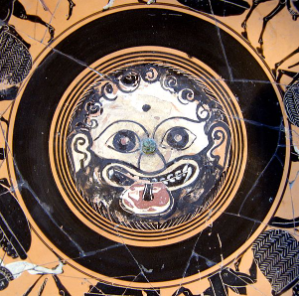
The Gorgoneion in ancient Greece was believed to have the power in deflecting misfortune or averting the evil eye. Image: Gorgoneion on the Tondo of an Ancient Greek Attic black-figure cup – Cabinet des médailles de la Bibliothèque nationale de France, Paris, France.
The Children of Perseus
By Andromeda, Perseus fathered a number of children, including seven sons and two daughters. The sons of Perseus are:
- Perses: He was a legendary hero who founded the city of Persia. Perses was left in Aethiopia by his parents.
- Alcaeus: He was a warrior who participated in the expedition of the Argonauts. He was also the grandfather of Heracles through his stepson Amphitryon.
- Electryon: He was a king of Mycenae and the father of Alcmene, the mother of Hercules.
- Cynurus: He was the eponymous founder of the city Cynura, an ancient district on the eastern coast of the Peloponnese.
- Mestor: He was a king of Taphos and the father of Hippothoe.
- Heleus: was a king of Mycenae and the father of Iphicles, the half-brother of Hercules.
- Sthenelus: He was a king of Mycenae and the father of Eurystheus, who was responsible for assigning the Twelve Labors to Hercules.
The daughters of Perseus are:
- Gorgophone: She was married to Perieres, the king of Messenia, and was the mother of Aphareus and Leucippus.
- Autochthe: She married Aegeus, a mythical figure who played a role in the founding of Athens. By Aegeus, she gave birth to many daughters.
The relationship between Perseus and Heracles
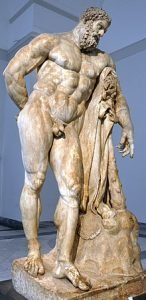
The Farnese Hercules (216 CE), Roman marble statue on the basis of an original by 4th century BC Greek sculptor Lysippos.
Alcaeus, a prince of Mycenae, was born to Perseus and Andromeda, and was the sibling of Perses, Heleus, Mestor, Sthenelus, Electryon, Cynurus, Gorgophone, and Autochthe. Alcaeus had multiple wives, including Astydameia, daughter of Pelops and Hippodamia, Laonome, daughter of Guneus, or Hipponome, daughter of Menoeceus. He was the father of Amphitryon, Anaxo, and Perimede.
Amphitryon was the husband of Alcmene, Electryon’s daughter. This made him the stepfather of the Greek hero Heracles.
According to the myth, Zeus, the king of the gods, fell in love with Alcmene and disguised himself as Amphitryon to sleep with her. As a result, Alcmene became pregnant with twins, one fathered by Zeus (Heracles) and the other by Amphitryon (Iphicles).
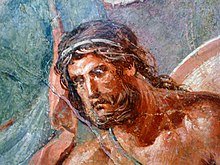
Amphitryon was a famous figure in Greek mythology and the son of Alcaeus and Astydameia (or possibly Laonome or Hipponome). He is best known for his marriage to Alcmene, who was the mother of the legendary hero Heracles.
Perseus – the legendary founder of Mycenae
Mycenae (located in present day Argolis, Greece) was an ancient city in the northeastern part of the Peloponnese peninsula in Greece. It was a significant center of Mycenaean civilization, which flourished in Greece during the Late Bronze Age, from around 1600 BCE to 1100 BC.
Mycenae is best known for its impressive archaeological site, which includes the ruins of the city’s fortified walls (i.e. the walls of Tiryns), palaces, and tombs. The most famous of these tombs is the Treasury of Atreus, also known as the Tomb of Agamemnon, a massive beehive-shaped tomb built in the 13th century BC.
Other famous ruins of Mycenae is the Lion Gate, the main entrance to the citadel of Mycenae. Located in the northeastern side of the acropolis, the gate was built somewhere 1252 BC. The name comes from the relief sculpture of two lionesses above the entrance.
According to Greek mythology, Mycenae was founded by Perseus, but its golden age is associated with the legendary king Agamemnon, who led the Greeks in the Trojan War. In Homer’s epic poem the Iliad, Mycenae is described as a powerful city-state, rich in gold and ruled by Agamemnon. Also according to Homer, the name of the city was derived from the nymph Mycene, the daughter of the river god Inachos of Argos.
Excavations at Mycenae have revealed evidence of a sophisticated civilization with a strong military and a complex social and political hierarchy. The city was well-connected to other centers of Mycenaean culture, such as Tiryns, Pylos, and Thebes, and traded with other civilizations in the eastern Mediterranean.
The archaeological site of Mycenae is a UNESCO World Heritage Site. It received the honor in 1999. Today, the site is a popular destination for tourists interested in ancient Greek history and culture.
How Perseus accidentally killed his grandfather King Acrisius
After completing his various quests, Perseus returned to his hometown of Argos. When news of Perseus’ return reached his grandfather Acrisius, the was consumed by the the prophecy that his own grandson would cause his death. As a result, Acrisius went into voluntary exile in Pelasgiotis (Thessaly). Meanwhile, Perseus competed in the funeral games held by Teutamides, king of Larissa, in honor of his father. During the discus throw event, Perseus’s discus went off course and accidentally struck Acrisius, killing him on the spot.
In a different account, it was said that Acrisius had been driven into exile by his brother Proetus. Perseus turned Proetus into stone using the Gorgon’s head and restored Acrisius to the throne. However, Acrisius accused Perseus of lying about slaying Medusa. To prove his innocence, Perseus showed Acrisius the Gorgon’s head, thereby fulfilling the prophecy.
How Perseus founded the ancient Greek city of Mycenae and established the Perseid dynasty
According to the myths, Perseus accidentally killed his maternal grandfather, King Acrisius of Argos. This action of the demi-god meant that he could not inherit the kingdom of Argos. Perseus then proceeded to trade his realm with the realm of his cousin, Megapenthes.
Known as the son of Proetus, Megapenthes was the ruler of Tiryns. Perseus then became the king of Tiryns. It was during his reign that he founded the city Mycenae. Perseus also established the Perseid dynasty, with his son Electryon (by his wife Andromeda) becoming the second ruler to hail from the dynasty.
Upon the death of Electryon, the throne passed on to Sthenelus, a son of Perseus. Sthenelus married Nicippe, a daughter of King Pelops of Elis. The pair had a son called Eurystheus, who tried to avenge the death of his father by imposing a set of 12 arduous labors (i.e., the Twelve Labors) on the Greek demigod Heracles.
Aside from the generally accepted myth that Heracles received those labors as penance for murdering his family, it is also stated that Heracles was punished because his son, Hyllus, killed Sthenelus. As a result of the enmity between Heracles and Eurystheus, the latter swore to wage war against the Heracleidae (Heraclids), the descendants of Heracles.
Ultimately, the Heraclids killed Eurystheus and all his sons, bringing an end to Perseid dynasty, which was succeeded by the Atreid dynasty, with its first ruler being Atreus. The myth goes on to say that Atreus gave birth to two sons – Agamemnon and Menelaus, who inherited the kingdoms of Mycenae and Sparta, respectively.
Read More: Greatest Heroes in Greek Mythology
Conclusion
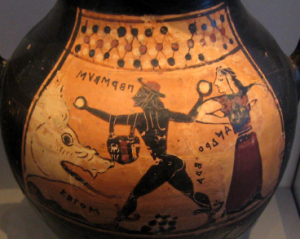
Greek demigod Perseus saving Andromeda from Cetus, depicted on an amphora in the Altes Museum, Berlin
The generally accepted account in Greek mythology is that Perseus is one of the most famous heroes in Greek mythology, known for his strength, bravery, and cunning in overcoming seemingly insurmountable challenges.
Bibliography
Apollonius Rhodius, Argonautica. George W. Mooney. London. Longmans, Green.
Beekes, Robert Stephen Paul. Etymological Dictionary of Greek. Leiden and Boston: Brill, 2009.
Blakolmer, Fritz (2010). “Images and Perceptions of the Lion Gate Relief at Mycenae during the 19th Century”. In F. Buscemi (ed.). The Representation of Ancient Architecture in the XIXth Century. Cogitata. pp. 49–66.
Bury, J. B.; Meiggs, Russell. A History of Greece (4th ed.). London: MacMillan Press, 1975.
Castleden, Rodney. The Mycenaeans. London and New York: Routledge, 2005.
French, Elizabeth Bayard. Mycenae: Agamemnon’s Capital. Stroud: Tempus, 2002.
Herodotus, The Histories with an English translation by A.D. Godley. Cambridge. Harvard University Press.
Mylonas, George Emmanuel. Mycenae and the Mycenaean Age. Princeton, NJ: Princeton University Press, 1966
Ogden, Daniel. “Perseus.” Routledge & CRC Press, 2008
